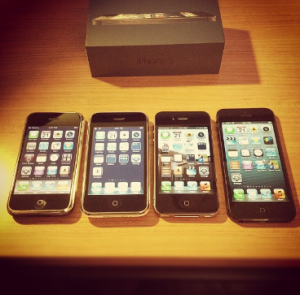
The iPhone Illusion and the U.S.-China Trade Deficit
In April of this year, the U.S. trade deficit with China hit a two-year high of $47.2 billion, its largest bilateral deficit with any nation. The Chinese trade deficit is often used as a political rallying cry by politicians looking to bring back jobs and end reliance on cheap Chinese labor, but in a global economy as complex as ours, how much do bilateral trade statistics even mean?
For an American, the answer can probably be found in your pocket. Look at the back of any iPhone and you will see this catchy little phrase: “Designed by Apple in California, Assembled in China.” To say this is an oversimplification would be an understatement. Between being designed in California and assembled in China, your iPhone travels to Japan, South Korea, Germany, and back to the U.S., with each destination adding significant value to the final product along the way. All the parts from this process are eventually sent to China, where workers assemble the parts and export the finished product.
The problem with bilateral trade statistics, especially with countries like China, is that when an iPhone is exported from China to the U.S., the entire value for the product is attributed to China despite the assembly process only contributing about 3.6% of the value. Our approximately $2 billion iPhone-specific trade deficit with China distorts reality and creates misguided policies on how to address economic relations with China.
In order to capture the realities of a truly global supply chain, value-added trade statistics are much more suited for a 21st century international economy. When adjusting for the actual value China adds to the production of an iPhone, the deficit shrinks to $73 million. Does the U.S. still run trade deficits with China that are probably unsustainable in the long run? Absolutely. But don’t read too much into the doom-and-gloom predictions made by politicians looking to shut us off from the benefits of international trade.
Instead of trying to end reliance on China by turning inward, we should look for other markets that will help trim down the deficit. The Trans-Pacific Partnership will allow the U.S. to diversify its source of exports as well as show commitment to our allies situated in the increasingly turbulent Pacific Ocean. The Trans-Atlantic Trade and Investment Partnership will further solidify our relationship with Europe through a long overdue free trade deal between the U.S. and the EU. It is the national interest of the U.S. to ensure these trade deals are completed in a timely fashion.
Additionally, the U.S. needs to continue to put pressure on Beijing to quit playing fast and loose with the internationally accepted rules on currency valuation. With e-commerce giant Alibaba set to make a China-sized splash in the U.S. stock market later this summer, we need to ensure there is a level playing field in the industry. More effort should be put into bringing World Trade Organization suits against China as an increasing number of Chinese companies look to go global.
As China’s miraculous growth over the last few decades has lifted millions out of poverty, it is slowly but steadily losing its comparative advantage in manufactured goods, a process that would accelerate if its currency is allowed to float. The U.S. has a long way to go if it wants to slow its appetite for Chinese goods, but the solution lies in diversifying its international trade practices, not in trying to stop them.







… [Trackback]
[…] Read More here: americansecurityproject.org/the-iphone-illusion-and-the-u-s-china-trade-deficit/ […]